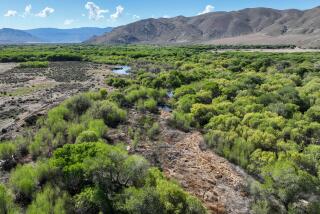In Central Coast cattle region, drought continues to shrink the herds

Roughly 75% of the cattle in San Luis Obispo County has been sold or taken out of state over the past four years to escape conditions in the most drought-stricken region in California.
Reporting from Shandon, Calif. — From the front porch of the ranch house where Daniel Sinton grew up, the toll of drought is all too plain to see.
Grassland is turning into bare ground. Pine trees, some four stories tall, are dead or being eaten alive by fungal pathogens. And Sinton’s cattle herd has shrunk to one-fifth its usual size.
Canyon Ranch, started near San Luis Obispo by Sinton’s great-grandfather 150 years ago, is withering from lack of rain, as are most other ranches in this once-thriving cattle region. Roughly 75% of the cattle in San Luis Obispo County have been sold or taken out of state over the last four years to escape conditions in the most drought-stricken region in California.
“You’re looking at the whole shebang,” said Sinton, 34, as he looked out over a few dozen head of cattle grazing on dry grass. “That’s all the cattle we’re running right now.”
Since the late 1700s, grazing has been the best use for the region’s rolling hills and valleys. Vast tracts of chaparral and oak forests made farming difficult; the soil is generally too shallow for crops, and surface water is limited.
Cattle ate vegetation watered mostly by rainfall rather than by aquifers. But last year, the area received just a quarter of its usual rain: 2.24 inches, down from the average of 9.85 inches. Available forage was 5% of normal, meaning that when rains return, poorer seed production and ground cover will require several years of conservative grazing to restore normal productivity to range lands.
A huge sell-off of cattle by ranchers thinning their herds last year brought in a record $129 million, as beef prices were high and more livestock than usual were sent to auction.
This year, with the number of livestock way down, cattle sales will plummet, local officials say. To make things worse, getting the animals to market has become more costly because the most heavily attended local cattle auction has closed.
Templeton Livestock Market was sold to a developer who plans to build 110 homes on the property. Ranchers now have to ship their cattle to markets more than 100 miles away.
“We see clearly what a bust cycle looks like,” said Mark Battany, the county’s viticulture and soils farm advisor. “Ranchers have no choice but to sell off their cows and rebuild the herd when the rain comes back.”
Many ranchers say they are hunkering down, determined to ride out the drought. Once it ends, Sinton said, “it’ll take a decade to rebuild the herd.” And that assumes water will be plentiful for the 10 years.
As dire as conditions are, they are not new to a ranching industry that has survived dry spells over the centuries.
During a drought that ended in 1864, some ranchers drove their herds off cliffs and into the ocean below to stop their suffering.
Sinton’s grandfather, James Sinton, 98, the family historian, pointed out that “in the drought of 1898, people ran out of hay and started feeding cattle anything that was green, including chopped-up sycamore trees. It was that, or the cattle just died.”
“The current drought is worse,” he said. “I’ve never seen one last this long.”
Ranchers today do have one advantage their ancestors didn’t enjoy: a burgeoning Central Coast wine industry. Sinton has converted 120 acres of his 6,000-acre Canyon Ranch, 25 miles northeast of San Luis Obispo, into vineyards. He found that the vines yield higher economic returns on water than ranching.
Other ranchers have done the same, but now that option is also on hold because of the dry conditions. Alarmed by declines in the Paso Robles Groundwater Basin, the county enacted a two-year moratorium last year on new agriculture dependent on the aquifer.
If a rancher had enough foresight to start a vineyard before the moratorium or is lucky enough to have other sources of water on the property, grapes remain an option. But the county won’t allow new vineyards using groundwater.
“Ranchers are getting hit hard from every direction,” said Royce Larsen, San Luis Obispo County’s natural resource watershed advisor. “It’s a grim and desperate outlook.”
At Canyon Ranch, Sinton also frets about the fate of the trees, including the struggling pines and thousands of oaks that have shed their leaves to conserve water.
“The sound of wind blowing through the pines is gone forever,” he said, walking past the skeletal remains of a grove he explored as a boy.
Nearby, researchers are trying to determine why the drought is killing the trees. They are investigating the coping mechanisms of blue and valley oaks and creating a baseline of data to gauge future changes.
“When it comes to struggling trees, these are the worst I’ve ever seen — and it’s only the beginning of the dry season,” said Blair McLaughlin, a University of Idaho professor who is leading a research team from UC Berkeley. “We have a lot to learn from a place like this about what drought is doing throughout the state.”
Twice a day, McLaughlin and Andrew Weitz, a graduate student at UC Berkeley, stride into the forest and cut stems off selected trees that will be used to determine their level of water stress.
Trees are stressed when it becomes difficult for their roots to pull moisture from the soil and channel it to leaves via a network of water-conducting tissues collectively called xylem. When roots cannot keep pace with the amount of moisture released into the atmosphere through pores in the leaves, it results in an unhealthy deficit of water in the xylem.
The larger the water deficit, the more trees experience stress, which curtails growth and makes them more susceptible to insects and disease.
Although the drought has killed many blue, valley and coastal oaks, healthy trees can shed their leaves several times without significant long-term effects, McLaughlin said.
“California’s native oaks are well adapted to periodic drought,” she said. “They may well green up again after a few good years of rain.”
Terry Jones, an anthropologist at Cal Poly San Luis Obispo, believes an increase in tooth cavities found in the remains of Native Americans is circumstantial evidence that oaks continued to produce sugar-rich acorns during a drought that began in 900 and lasted to 1400.







